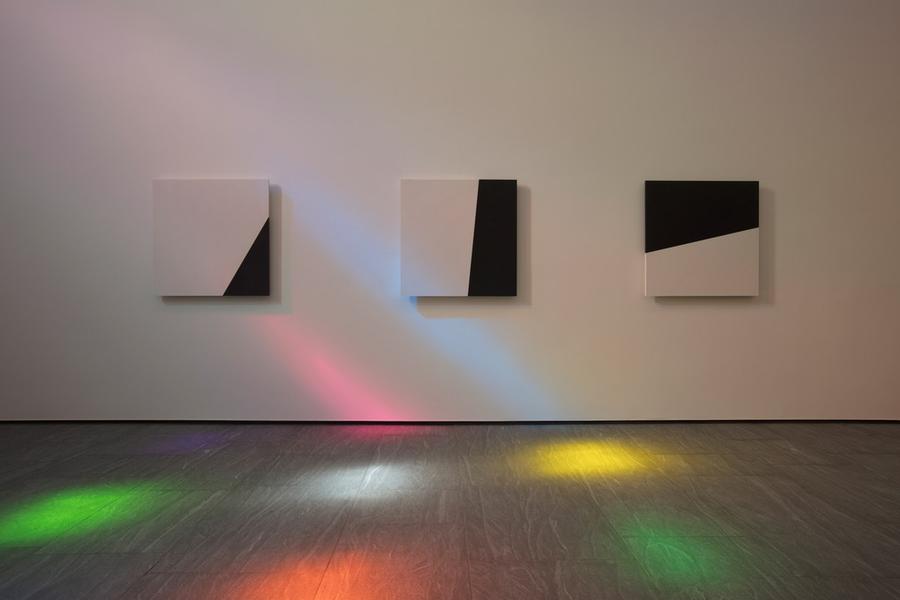Ellsworth Kelly's Final Work, His Only Building, Debuts in Austin
- AUSTIN, Texas
- /
- February 20, 2018

The Blanton Museum of Art at The University of Texas at Austin raised $23 million to fabricate and endow Ellsworth Kelly's Austin, the late artist's only building, a Romanesque-style church lit with rainbow-hued glass windows.
Coninciding with the building's opening last weekend, the exhibition "Form into Spirit: Ellsworth Kelly’s Austin" (February 18 – April 29, 2018) explores the conceptual origins of Kelly's last work, a 2,715-square-foot freestanding building named for the city in which it resides. Kelly died in 2015.

Curated by Carter E. Foster, the Blanton’s Deputy Director for Curatorial Affairs, the show coincides with the opening of Austin, which is a monumental structure with luminous colored glass windows, a totemic wood sculpture, and fourteen black-and-white stone panels in marble and granite. The first and only building the artist designed, Austin was gifted as a design and concept to the museum in January 2015.
“Ellsworth Kelly’s Austin will be a bold new landmark for the university and our city,” Blanton Museum Director Simone Wicha said in a statement. “Form into Spirit celebrates the Blanton’s installation of this monumental work of art by one of the most important American artists of the past century, and will help illuminate its decades-long genesis.”

Austin is the culmination of many of Kelly's lifelong interests in form, geometry, and color. Form into Spirit is arranged around four main motifs of Kelly’s work throughout his career—Color Grid, Spectrum, Totem, and Black and White—all of which play a key role in Austin.
Color Grid Austin is Kelly’s only artistic work in glass; three of its façades feature stained glass windows. Its south façade features a three-by-three grid of colored square panes with a clear window at the center. The artist first explored grids of color in collages he made using cut pieces of gummed papers. Some of these collages led to larger-scale paintings, among his first important and monumental mature works, such as Colors for a Large Wall (1951). The collage for this painting will be included in Form into Spirit, along with both the collage and painting Sanary (1951), another significant work of this type. Other color grids are pared down and use just nine squares of colors. They are the direct precedents for Austin’s south façade and show the artist playing with proportion, spacing, and the ratio of color to black and white.
Kelly developed his idea of a color spectrum instinctively rather than scientifically. His first Spectrum used a squarish format of thirteen separate strips of color. This number allowed for symmetry of the color bands, with the darkest central band flanked by six on either side, always moving towards lighter yellows at the lateral edges. The Museum of Modern Art in New York is lending its monumental painting Spectrum IV (1967) to Form into Spirit, a notable, early example of this type of work.
The east and west stained-glass window compositions in Austin use the spectrum gradation of color but in new formats: one a wheel of long rectangles, the other a circle of tumbling squares that Kelly distilled from one of the windows in Chartres cathedral.
Kelly called his towering sculptures “Totems,” and they are defined by a mathematical precision; their sides are always a segment of a circle, often a massive one, such that the curvature can be almost imperceptible. The Totem sculptures featured in Form into Spirit will show how the artist worked out their forms in multiple scales and materials, including stainless steel, painted aluminum, and bronze – culminating with the redwood Totem located in Austin’s curving apse.
Kelly’s black-and-white works reveal the artist at his most reductive. By removing color as an option, he could focus on the weight and balance of forms and the purity of a composition. Positive and negative space is one of the fundamental givens of painting, and with Kelly’s works reduced to these two non-colors, spatial relationships and figure-ground dichotomies can be emphasized or eliminated, depending on the work’s relationship to its physical space.
Austin features a series of fourteen panels of black and white marble that truly represent the culmination of a career-long use of black and white; they also mark Kelly’s first time working in marble. The center section of the show deals directly with Austin's genesis, including rarely seen early paintings and drawings that fuse Judeo-Christian themes with the artist’s own modern aesthetic, making clear Austin’s decades-long germination. This section will also include an early model and designs Kelly produced during the building’s initial conception in the mid-1980s. Perhaps the most quietly powerful item here is a drawing of a church in Marly le Roi, France, which reflects Austin’s long lineage in Kelly’s work. This was made in 1944 when he was stationed near Paris while serving in the army, when he began his long love affair with European architecture and art.
"Austin not only showcases Kelly’s early appreciation of historical European art and architecture,” Foster said. "It also marries this passion with the transformative themes that he would discover over the course of his life. I hope that, with the help of this exhibition, everyone who visits the work comes away with the same sense of awe that I do."







5100x100_c.jpg)







